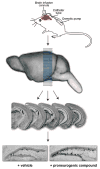Development of proneurogenic, neuroprotective small molecules
- PMID: 21210688
- PMCID: PMC3033481
- DOI: 10.1021/ja108211m
Development of proneurogenic, neuroprotective small molecules
Abstract
Degeneration of the hippocampus is associated with Alzheimer's disease and occurs very early in the progression of the disease. Current options for treating the cognitive symptoms associated with Alzheimer's are inadequate, giving urgency to the search for novel therapeutic strategies. Pharmacologic agents that safely enhance hippocampal neurogenesis may provide new therapeutic approaches. We discovered the first synthetic molecule, named P7C3, which protects newborn neurons from apoptotic cell death, and thus promotes neurogenesis in mice and rats in the subgranular zone of the hippocampal dentate gyrus, the site of normal neurogenesis in adult mammals. We describe the results of a medicinal chemistry campaign to optimize the potency, toxicity profile, and stability of P7C3. Systematic variation of nearly every position of the lead compound revealed elements conducive toward increases in activity and regions subject to modification. We have discovered compounds that are orally available, nontoxic, stable in mice, rats, and cell culture, and capable of penetrating the blood-brain barrier. The most potent compounds are active at nanomolar concentrations. Finally, we have identified derivatives that may facilitate mode-of-action studies through affinity chromatography or photo-cross-linking.
Figures











References
Publication types
MeSH terms
Substances
Grants and funding
LinkOut - more resources
Full Text Sources
Other Literature Sources

